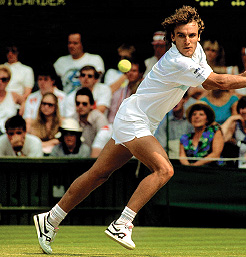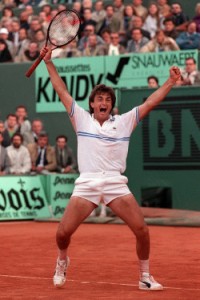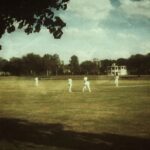Great Tennis Memories: Mats Wilander “In The Zone”

Mats Wilander was in the "zone" in 1988 as he won three Grand Slam titles.
“In the flow, in a groove, on a roll, in the zone—whatever you call it, it’s all defining one thing. It’s that special feeling of thinking you can do no wrong and everything goes your way. You are so involved in what you are doing that nothing else seems to matter because you are so connected to your task.
When former Boston Celtic star Bill Russell characterizes being in the zone, he says it is a moment when everything goes so perfectly that you slip into a gear that you didn’t even know was there…”
— Karelene Sugarman, M.A.
In tennis, being in the “zone” can last for a game, a set, or a match—sometimes it can last for a whole tournament. Few players, however, can claim to being in the “zone” for an entire year.
Certainly, John McEnroe could plant a flag on 1984, when he lost only three matches the entire year, and Roger Federer could lay claim to 2005, when he lost a mere four times.
Mats Wilander came close when he discovered that 1988 was the stuff of “zone” magic. He won three out of the four majors and seized the No. 1 ranking from Ivan Lendl at the conclusion of the 1988 U.S. Open.
But his true “zone” match occurred during the 1988 French Open final as Wilander faced Frenchman Henri Leconte before a crowd definitely favoring one of their own. For Leconte, of course, Paris was home town territory.
Truth be told, it was Wilander’s fifth French Open final. He had won his first at the age of 17 in 1982, defeating Guillermo Vilas in the final and his second in 1985 when he overcame Ivan Lendl.
One of Wilander’s losses in 1983 was to Frenchman Yannick Noah. The win made Noah a national hero in France. The support given Noah during the match was a huge factor in his win over Wilander. The Swede advanced to the French Open finals again in 1987, where he suffered defeat at the hands of his unparalleled rival—Ivan Lendl.
For 24-year-old Henri Leconte, an unorthodox left-handed serve-and-volley player, this would be his first grand slam final. He had arrived unexpectedly by outplaying surprise semifinalist Jonas B. Svensson. Svensson had removed Ivan Lendl from contention in the quarter-finals.
Wilander, meanwhile, had his hands full in the semifinals with an up-and-coming Andre Agassi, who embraced the moment and the French crowd with his particular free spirit approach to the contest. Agassi groaned, grunted, yelled, and played to the crowd, appealing for support.
The struggle lasted five grueling sets until the 18-year-old American finally ran out of gas, sending a pleased Wilander into the final.
Wilander realized that playing Leconte presented problems on many levels. First was the style of play. A serve-and-volleyer would capitalize on Wilander’s second serve; therefore, it would be critical to serve well, firing in as many first serves as possible.

The 1988 French Open was the only Grand Slam finals appearance for Frenchman Henri Leconte.
Wilander’s passing shots would have to be pin-point accurate. More importantly, the Swede would have to keep Leconte pinned on the baseline. That meant returning Leconte’s serve deep, allowing the Frenchman no short balls and no chance to move into the net.
The other factor was the crowd.
After playing and losing to Noah, Wilander knew that keeping the crowd out of the match was important. He also realized that was highly unlikely since he was playing a Frenchman in the final.
It would be necessary, therefore, to block out the crowd and not let them affect his play. Utmost concentration would be required.
The Match
The day was damp and dreary. It spit rain off and on throughout the match. The proceedings began with the singing of the “La Marseillaise” and a flyover by French Air Force jets. The French cheered loudly for their home town boy. Wilander took it all in but poured his effort into concentrating on the man across the net.
As the match got underway, the balls soon grew heavy, causing play to slow. Leconte fought his nerves and the damp conditions. Finally, at four-all in the first set, an impatient Leconte broke free of the punishingly slow play.
He went for broke.
As Wilander served, an inspired Leconte’s return pushed the Swede back behind the baseline, allowing Leconte a chance to move in, producing a forehand winner and securing the first point.
On the second point, Leconte drove Wilander’s serve back deep again and then cut a sharp volley, forcing Wilander wide. On the third point, Leconte drove the return deep again and then rushed the net. On the subsequent lob, Leconte drove a backhand down the line for a winner.
At game point, Leconte shot a backhand to the corner. He played a superlative game, breaking Mats Wilander at love, going up 5-4 in the first set. The crowd seized the moment and returned, cheering boisterously for their man.
Wilander stared at Leconte, recognizing that the match was on the line at this moment. If Leconte served out the set, Wilander would have another grueling match on his hands. He had to break back now or it was going to be a real struggle with the crowd stirring, anxious to see Leconte take this first set.
Serving for the set, therefore, Leconte faced a sternly resolute Wilander. During his first point on serve, Leconte came after the Swede with everything in his arsenal, but the Swede returned it all and then some—a drive, a lob and finally a sharp volley.
Wilander held his ground and won the point.
Under pressure Leconte double faulted. At game point, Leconte finally worked himself into prime real estate, establishing himself at the net, but he forced the ball long and Wilander broke back.
It was 5-5. Wilander held to go up 6-5 and broke Leconte for the set at 7-5.
Suddenly, the crowd turned sour and in the distance were faint rumbles of thunder. It was pretty much all over but the shouting, although no one knew it at the time. Leconte and his game went away and with it the crowd support.
Throughout the match, Wilander missed one first serve and forever denied the Frenchman any opportunity to impose his game on the match. He picked apart the left-handed Leconte with pin-point accuracy on his passing shots anytime the Frenchman worked his way into the net.
Wilander played flawless, almost perfect tennis—concentrating solely on the next point, the next ball or the next serve.
Wilander did come to the net on a few occasions but never once had to hit a volley because Leconte did not keep the ball in play. Hitting 97 percent of his first serves in the match, Wilander did not miss a first serve in the third set.
He won the match, 7-5, 6-2, 6-1 in one hour and 52 minutes, allowing Leconte only eight games in total. It was an almost perfect exhibition by the Swede who was working on a calendar-year Slam, having won the Australian Open in January of 1988.
Leconte, who was booed by the French during the trophy ceremony when he accepted the runner-up plate, described Wilander as a bulldozer. This perfectly tuned tennis machine was definitely in the zone on that fateful Sunday as he seized his third French Open crown from his hapless opponent in Leconte.
Wilander would miss his opportunity for a Grand Slam in 1988 by losing during the quarterfinals to Miloslav Mecir at Wimbledon. The Swede would take the U.S. Open and the No. 1 ranking from Lendl at the end of that glorious summer.
1988 was the year Wilander lived inside the “zone.” His best moment without a doubt was his French Open final against Henri Leconte.












